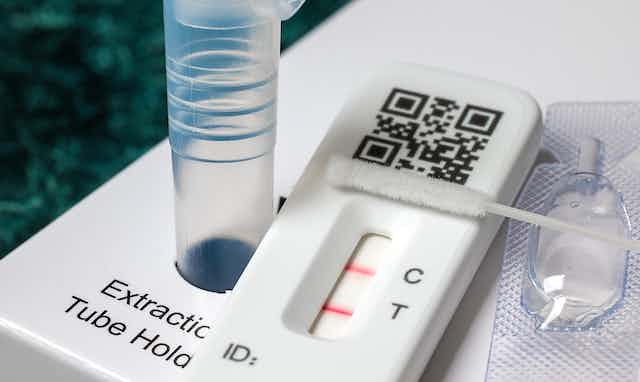COVID-19 testing has become a cornerstone in the global fight against the pandemic caused by the novel coronavirus, SARS-CoV-2. Testing has played a pivotal role in identifying cases, isolating individuals, and mitigating the spread of the virus. In this comprehensive article, we will explore the various types of COVID-19 tests, their importance in controlling the pandemic, testing guidelines, and the evolving landscape of testing as new variants emerge.
I. Types of COVID-19 Tests
There are several types of COVID-19 tests, each serving a specific purpose in the diagnosis and containment of the virus:
1. Polymerase Chain Reaction (PCR) Tests:
PCR tests are considered the gold standard for COVID-19 diagnosis. They detect the genetic material of the virus and are highly accurate. A healthcare professional collects a sample from the nose or throat, which is then processed in a laboratory. PCR tests are effective in detecting the virus in both symptomatic and asymptomatic individuals.
2. Antigen Tests:
Antigen tests, also known as rapid tests, detect specific proteins on the surface of the virus. They provide results more quickly than PCR tests and are often used for screening in various settings. While they are less sensitive than PCR tests and may have a higher rate of false negatives, they are valuable for quickly identifying potentially infectious individuals.
3. Antibody Tests:
Antibody tests, also known as serology tests, determine whether an individual has developed antibodies in response to a previous COVID-19 infection. They are not used for diagnosing active infections but can help identify individuals with past exposure to the virus. These tests play a role in understanding the prevalence of the virus in a population.
II. Importance of COVID-19 Testing
 The importance of COVID-19 testing cannot be overstated, as it serves multiple critical purposes:
The importance of COVID-19 testing cannot be overstated, as it serves multiple critical purposes:
1. Diagnosis and Isolation:
Testing allows for the timely diagnosis of individuals with COVID-19. Those who test positive can be isolated to prevent further spread, reducing the risk of transmission within households, workplaces, and communities.
2. Contact Tracing:
Testing is an essential component of contact tracing efforts. Identifying and testing individuals who have had close contact with confirmed cases helps contain outbreaks and prevent further transmission.
3. Surveillance and Monitoring:
Testing provides data that public health authorities use to monitor the prevalence of the virus within communities. This information guides decision-making regarding social distancing measures, lockdowns, and vaccination campaigns.
4. Asymptomatic Detection:
Many individuals infected with SARS-CoV-2 exhibit no symptoms (asymptomatic) or mild symptoms (presymptomatic). Testing is crucial for identifying these individuals, as they can still transmit the virus to others.
III. COVID-19 Testing Guidelines
Guidelines for COVID-19 testing have evolved over the course of the pandemic, adapting to changing circumstances and available resources. Here are some key considerations:
1. Symptomatic Individuals:
Anyone with COVID-19 symptoms, such as fever, cough, or loss of taste or smell, should get tested. Testing helps confirm the diagnosis and initiate appropriate isolation and treatment measures.
2. Close Contacts:
Individuals who have been in close contact with someone who has tested positive for COVID-19 should be tested, even if they are asymptomatic. Testing can help identify cases early, reducing the risk of further transmission.
3. Travel and High-Risk Settings:
Testing may be required for individuals traveling to areas with high transmission rates or for those in high-risk settings such as healthcare facilities, long-term care facilities, and congregate settings.
4. Quarantine and Isolation:
Testing is often used to determine when it is safe for individuals to end their quarantine or isolation periods. The timing of testing depends on the specific guidelines in place at the time.
5. Preoperative and Pre-procedure Testing:
Many healthcare facilities require COVID-19 testing before elective surgeries and procedures to protect both patients and healthcare workers.
IV. The Evolving Landscape of COVID-19 Testing
As the pandemic has progressed, the landscape of COVID-19 testing has continually evolved:
1. New Variants and Testing Challenges:
Emerging variants of SARS-CoV-2 have posed challenges to testing efforts. Some variants may affect the accuracy of certain tests, leading to ongoing research and development of more robust testing methods.
2. Home Testing Kits:
The availability of home testing kits has expanded, allowing individuals to test themselves in the comfort of their homes. These kits provide convenience and reduce the burden on healthcare facilities.
3. Rapid Testing Expansion:
Rapid antigen tests have become more widely available, offering quicker results. They are valuable tools for screening in high-risk environments and for frequent testing of certain populations, such as healthcare workers.
4. Mass Testing Events:
Mass testing events and community-based testing centers have been established to provide easy access to testing for large groups of people, especially in areas with high transmission rates.
V. Challenges and Considerations
 While COVID-19 testing has been instrumental in managing the pandemic, it is not without challenges and considerations:
While COVID-19 testing has been instrumental in managing the pandemic, it is not without challenges and considerations:
1. Testing Access: Ensuring equitable access to testing, particularly in underserved communities, remains a challenge. Disparities in testing rates must be addressed to control the spread of the virus.
2. False Negatives and Positives: No test is perfect, and both false negatives and false positives can occur. Clinicians must interpret results in the context of clinical symptoms and exposure history.
3. Testing Fatigue: As the pandemic has extended over time, testing fatigue has become a concern. Encouraging continued testing, even for those who have been vaccinated, is important for monitoring and controlling the virus.
COVID-19 testing has played a pivotal role in the global response to the pandemic. It serves as a cornerstone for diagnosing cases, identifying asymptomatic carriers, and monitoring the prevalence of the virus within communities. As the landscape of testing continues to evolve, it is crucial for individuals to stay informed about testing guidelines and recommendations. Ultimately, testing, along with vaccination efforts, remains a vital tool in our collective efforts to control the spread of COVID-19 and bring an end to the pandemic.



 The importance of COVID-19 testing cannot be overstated, as it serves multiple critical purposes:
The importance of COVID-19 testing cannot be overstated, as it serves multiple critical purposes: While COVID-19 testing has been instrumental in managing the pandemic, it is not without challenges and considerations:
While COVID-19 testing has been instrumental in managing the pandemic, it is not without challenges and considerations: Vaccine Types: Multiple vaccine candidates, including mRNA vaccines (Pfizer-BioNTech and Moderna), viral vector vaccines (Johnson & Johnson, AstraZeneca), and protein subunit vaccines (Novavax), were developed.
Vaccine Types: Multiple vaccine candidates, including mRNA vaccines (Pfizer-BioNTech and Moderna), viral vector vaccines (Johnson & Johnson, AstraZeneca), and protein subunit vaccines (Novavax), were developed.
